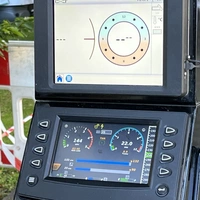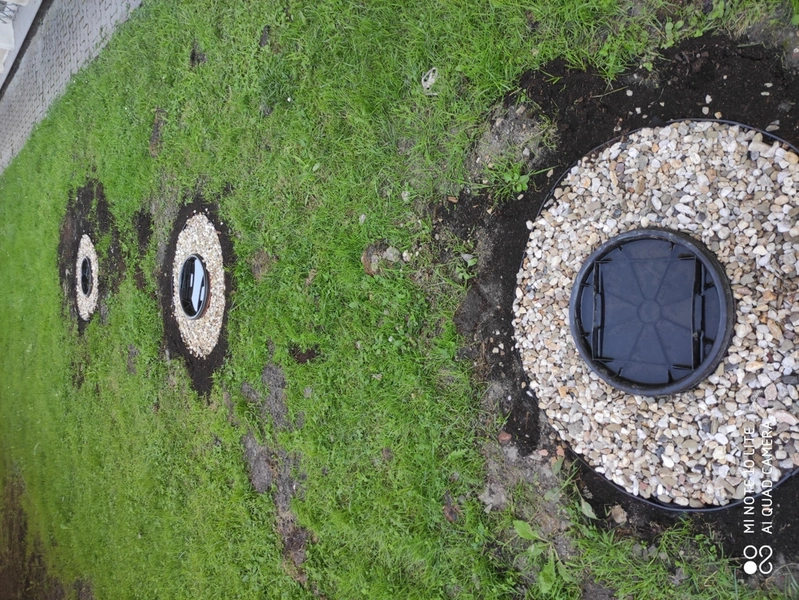Rozbudowa Laboratorium Geoenergetyki AGH-Innowacyjne otworowe wymienniki ciepła oraz dublet geotermalny na polu badawczym B Laboratorium Geoenergetyki AGH
Nazwa handlowa
Rozbudowa Laboratorium Geoenergetyki AGH-Innowacyjne otworowe wymienniki ciepła oraz dublet geotermalny na polu badawczym B Laboratorium Geoenergetyki AGH
Opis techniczny
Instalacja składa się z kilku form pozyskiwania ciepła Ziemi oraz magazynowania energii. Występują w niej:
- dublet studni, które mają za zadanie produkcję i zatłaczanie wody podziemnej unoszącej ciepło. Woda przepływając w dublecie pomiędzy dwoma studniami trafia do parownika pompy ciepła. Ze względu na mineralizację wody zastosowano pośredni czynnik grzewczy w postaci roztworu wodnego glikolu monopropylenowego ora dodatkowy wymiennik ciepła zbudowany z odpornych na korozję materiałów. W instalacji pracuje w związku z tym glikolowa pompa ciepła, przekazując ciepło na cele grzewcze w pawilonie D2;
- dwa otworowe wymienniki ciepła z bezpośrednim parowaniem. Stanowią więc parownik specjalnej (drugiej) pompy ciepła w instalacji. Otwory wyposażone są w termometry umieszczone co 10 m do głębokości końcowej, tj. 30 m p.p.t.;
- dwa wymienniki horyzontalne, z których jeden jest zainstalkowany z podwójną U-rurką z rur PE DN40 w otworze wykonanym metodą przewiertu sterowanego HDD (horizontal directional drilling), a drugi zainstalowano w istniejącej rurze pod ulicą rozdzielającą pawilony A4 i D2 na kampusie AGH w Krakowie. Poziome otworowe wymienniki ciepła pracują jako niskotemperaturowe źródło ciepła dla wcześniej zainstalowanych dwóch glikolowych pomp ciepła;
- trzy otwory do głębokości 30 m p.p.t., z których dwa służą do magazynowania energii w formie ciśnienia, stanowiąc objętość dla magazynowania sprężonego powietrza. Trzeci otwór magazynuje energię w postaci potencjalnej. Umieszczony w nim obciążnik ma możliwość poruszania się w górę i w dół. Dzięki temu tworzy magazyn, gdzie położenie dolne obciążnika oznacza w pełni rozładowany, a położenie górne w pełni naładowany magazyn. Wszystkie trzy otwory służą do magazynowania nadmiarowej energii elektrycznej z paneli fotowoltaicznych.
Warunki udostępniania infrastruktury
Infrastruktura badawcza jest udostępniana do badań za pośrednictwem pracowników WWNiG AGH. Badania, na podstawie odpowiednich umów z AGH, realizować będą przedstawiciele Laboratorium Geoenergetyki AGH.
Rodzaj akredytacji / certyfikatu:
Nie dotyczy
Rodzaj dostępu
Zewnętrzna
Możliwości badawcze
Infrastruktura ma możliwości:
- badań wpływu parametrów eksploatacyjnych na efektywność otworowych wymienników ciepła,
- badania oporów przepływu i strat mocy hydraulicznej wymienników otworowych,
- badania efektywności energetycznej pozyskiwania ciepła z wód podziemnych,
- badania różnych konstrukcji otworowych wymienników ciepła (różnych rur),
Data ostatniej aktualizacji
27 września 2024 08:48
Rok wprowadzenia do użytkowania
2023
Zdjęcia

3 otwory wiertnicze do 30 m dla magazynowania energii

Przyłącze otworowych wymienników ciepła z bezpośrednim parowaniem czynnika roboczego

Wnętrze studzienki zbiorczej z podłączeniem 18 otworowych wymienników ciepła

Pulpit sterowniczy urządzenia wiertniczego HDD podczas wiercenia horyzontalnego otworowego wymiennika ciepła

Jednostka odpowiedzialna